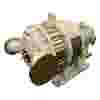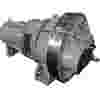Dry Chlorine
The chlorine gas is produced by a process of electrolysis. After the cooling and drying stages, the gas enters the liquid ring compressor to begin the ‘chlorine compression and liquefaction process’.
At this process stage, it is essential to maintain a specific temperature of the gas at the compressor inlet to prevent corrosion and safety issues. The isothermal feature of Garo Liquid Ring Compressors allows the gas to maintain the right temperature and to run the process safely. Additionally, the ability of Garo compressors to run with different seal liquids, and specifically sulfuric acid, allows the process to be handled by steel or iron equipment.
Once compressed, the chlorine gas is then liquefied through cooling. The cooling process requires strict temperature and pressure controls in order to work effectively. Once again, GARO compressors play a key role in the process, by ensuring that the required discharge pressure is achieved prior to the chlorine being passed to the after-condenser for the condensation process.



